Dave's Place
Changing a Type 1 Cooling Unit
See the pages on cooling unit safety, electrical safety, and propane safety before attempting the following procedures.
Pulling the Refrigerator
The first step in changing a cooling unit is to pull the refrigerator from its cabinet in the RV. Start by turning off the propane at the main bottle(s) and burning off any residual in the lines at a stove top burner. Next, from the outside access door for the refrigerator, disconnect the propane line to the refrigerator, unplug the 120 volt cord, and disconnect the 12 volt wiring to the refrigerator. Tape up the ends of the 12 volt wires with electrical tape to prevent sparking. While back there locate two screws that are usually at the bottom outside edges of the refrigerator, securing it to the cabinet floor, and remove them. Some RV manufacturers have thin steel plates fastened to the refrigerator, which are in turn bolted at the side to framing of the RV. These bolts (if present) can be seen and removed from the outside access door.
Next remove the refrigerator doors. After that, most models have four to six mounting screws on the face of the refrigerator, usually covered with plastic plugs. See graphic below. These need to be removed. Look for any other fasteners that might prevent removal of the refrigerator. Next, inside the RV, underneath the refrigerator, there is usually a bead of silicone that needs to be cut with a razor knife. The refrigerator should then be free and slid into the RV. If it doesn't move, look around for something else holding the refrigerator in. Sometimes RV manufacturers create their own ways of securing the refrigerator. If possible, take the refrigerator out of the RV to a larger work area.
Cooling Coil RemovalFrom inside the box, remove all screws or bolts on the back wall of the freezer. In the lower box, on the aluminum fins, there will be a capillary tube (sensor) from a thermostat or a thermistor (a sensor with wires) attached. This needs to be removed. On older single door models (774 and 776), the capillary is hidden. It comes through the back of the box under the fins in the middle and immediately goes up into the hollow part of a fin. Locate the capillary and pull it down out of the fins. Remove all fasteners on the fins. The fins do not come off at this time. In fact, although the fins could come out with the cooling unit, it is preferable that they remain in the refrigerator after the cooling unit has been removed. If they come out with the cooling unit, they then need to be removed from the unit and placed back in the box. |

|
| Once the work inside the refrigerator is done, lay the refrigerator on it's face. Depending on the circumstance, it may be necessary to lay an old blanket down to protect the face of the refrigerator. The cooling unit is the set of coils on the back of the refrigerator, extending from the top to the bottom. This is what we're after. Obvious parts such as burner assemblies, heat elements etc. need to be removed from the unit. Anything in the way of pulling the cooling unit needs to be removed. There are handful of screws holding the cooling unit to the refrigerator that need to be removed. See graphic below. There are also numerous small screws securing the backing that also need to be removed. |
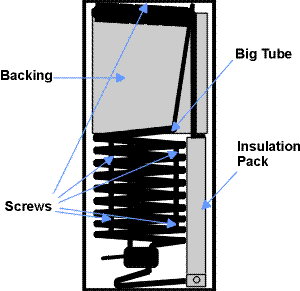
|
|
After all fasteners have been removed, the cooling unit is ready to pull. A pry bar under the "big tube", as in the graphic below, will usually do the job. The "big tube" is the only pipe that should be pried on. Since you will be prying against the refrigerator body, a board or some other protection is necessary between the pry bar and the refrigerator to prevent poking a hole in the box. This is usually enough to pull a cooling unit, but not always. If yours is stubborn, peel up the edges of the backing paper (or remove the plastic backing, depending on model) to expose a line between the foam block of the cooling unit head and the insulating foam of the refrigerator box. A large knife run around this line (about 4" deep) and then prying as before will remove the more difficult units. If you're still having problems, go back and be sure you have removed all fasteners. In some severe cases, it is alright to dig out some of the foam underneath the backing to break the unit free. Be careful not to damage the foam of the refrigerator box. The replacement cooling unit will have an intact foam block. Once the cooling unit is out, pull the baffle from the cooling unit chimney, remove the heat element, and any other parts (except the insulation pack) from the unit. On some models the insulation pack needs to be removed to get to the heat element. On these models the socket that holds the electric heat element is loacted behind the front pipes. Sometimes the element is stuck in its socket and tapping it out with a blunt drift is necessary. Not transferring the baffle from the old unit to the new one is the most common mistake made by installers. Be sure you are familiar with what the baffle is. You're now done with the removal. Normally, the only thing left on the old cooling unit after it has been changed, is the insulation pack. |
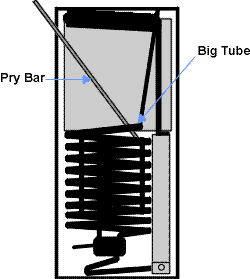
|
Cooling Coil InstallationIn these graphics, the is a metal to metal
contact point that requires thermal mastic. The is a metal to metal
contact point that requires thermal mastic. The
 refers to a fit point -- a point where the
cooling unit has to make good, snug contact with the refrigerator box. In the bottom blow-up graphic
the fins are shown being attached to the cooling unit. This is for explanation. The fins
are usually left in the box and attached to cooling unit later. refers to a fit point -- a point where the
cooling unit has to make good, snug contact with the refrigerator box. In the bottom blow-up graphic
the fins are shown being attached to the cooling unit. This is for explanation. The fins
are usually left in the box and attached to cooling unit later.
|

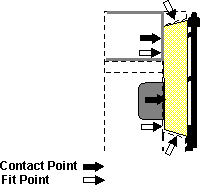
|
| The foam block of a cooling unit is not a precision part and often doesn't fit precisely when one cooling unit is being exchanged for another. It may need to be trimmed or it may have gaps along the sides that need to be filled in. The first thing to do is get a measurement between the top screw holes of the cooling unit and the top edge of the foam block, and compare it to the measurement between the top screw holes of the box and the upper edge of the cavity in the refrigerator. See graphic below. If these measurements are not the same, the top or bottom of the foam block needs to be trimmed to make the holes line up with the box. If more than a 1/4" is removed, the part removed needs to be placed in the box on the opposite end of the cavity. It's a good idea when installing a cooling unit to first place it into the refrigerator to see how it fits before committing to the installation. The cooling unit needs to fit all the way into the refrigerator cavity and not be held back by any part of the foam block. If there is a part of the foam block not fitting, a rasp can be used to shave it down. |
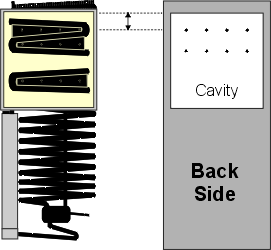
|
|
The sides of the foam block need to be sealed with thermal mastic or silicone to prevent air leaks. As it turns out, thermal mastic is also a good sealer. If you have a tube of it, you can use the mastic to seal around the foam block of a cooling unit to prevent air leaks. The advantage of the mastic over other sealers like silicone is that it doesn't glue the cooling unit to the box, making it easier to pull the cooling unit at a later date. Other parts of the cooling unit give off heat and the slightest air gap around the foam block will allow this heat into the refrigerator box and diminish the cooling. Apply a 3/8" bead of thermal mastic to the coils of the cooling unit that contact the aluminum fins and freezer of the refrigerator. Refer to the graphic. The foam block always has a backing of some sort. This backing should be secured to the refrigerator with screws and/or tape. We're looking for a good, snug fit with the cooling unit all the way into the cavity of the refrigerator and no air leaks. |
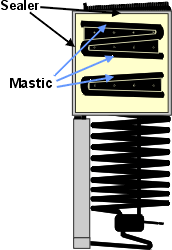
|
|
Though a little awkward, it's a good idea to set the refrigerator upright and make sure
the screw holes in the freezer line up with the holes in the cooling unit. If they do,
install a few screws to keep them in place. If they don't line up, you need to pull the
cooling unit and find out why, and then correct the problem. Drilling new holes is |
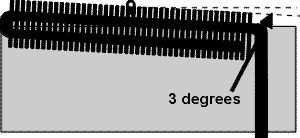
|
| The next angle of importance on a Norcold is the boiler and rectifier. The boiler is inside the insulation pack and is the same tube as the rectifier. This tube needs to set parallel to the edge of the refrigerator. You accomplish this by moving the lower half of the cooling unit, side to side. Install the screws as in the graphic below. It is very unlikely that the screw holes in the replacement cooling unit will line up with the holes in the box. You will have to make new holes with the old, self tapping screws. |
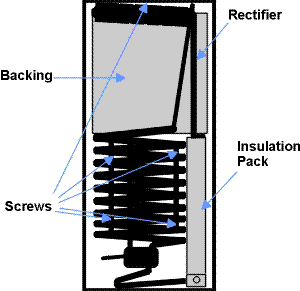
|
| Install all the peripherals that you had removed earlier (heat elements, baffle, burners etc.). Once everything on the back of the cooling unit has been installed, tape the edge of the backing with duct tape or better to prevent air from entering the refrigerator around the cooling unit. Set the refrigerator upright and replace the parts that were removed earlier inside the refrigerator. Finish installing the freezer screws. This is also the time to put the screws in the fins in the lower box. Don't be surprised if you don't see corresponding holes in the cooling unit behind the holes in the fins. Norcold used several different fin styles and the fins tend to move a little while loose in the box. Place the end of an awl or similar tool in the fin holes and scout around the edges of the hole for the corresponding hole of the cooling unit. Once found, pry the fins over to the hole. Sometimes the fin tears a little. Do not drill new holes. If there is a big tear, put a washer on the screw before installing it. Next, rock the refrigerator back and forth (front to back) several times to insure that the liquids inside get to where they are supposed to be. |

|
Installing the Refrigerator
Install the refrigerator back into the RV and make the necessary connections for the electrical and gas. Look back at the safety issues mentioned at the top of this page before continuing. Test for propane leaks at the connections you have made and all gas parts on the refrigerator. See propane safety for more on leak testing. The refrigerator should set upright about 30 minutes before being put into operation. If possible, test the refrigerator on 120 volt first, only because there are less variables on the electrical side than on propane. You should see signs of cooling in the freezer in an hour or hour and a half, and an empty box should come down to temperature in six to eight hours.
RV Refrigerator Home
This RV refridgerator information was originally located on rvmobile.comRV Mobile Inc. 11715 HWY 99, Everett, WA 98204
The owner of RV Mobile Inc. apparently suffered a heart attack and the original website was shut down.
It has been reposted here to preserve this wealth of information RV refridgerator information.